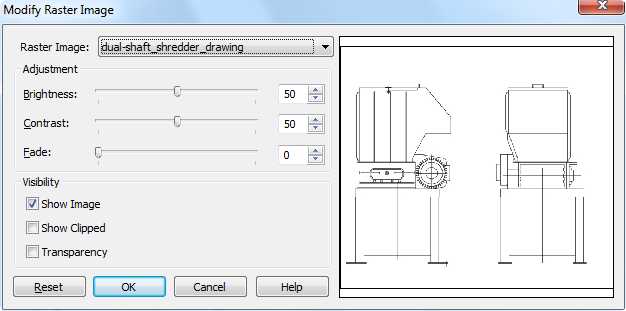Image Adjust







You can adjust the brightness, contrast and fade for the display of the raster image without affecting the original raster image file. The image adjustment is intended for improvement of the display of raster images (adjust contrast to make poor-quality images easier to read) or special effects.
Bitonal images cannot be adjusted for brightness, contrast or fade.
Raster image is selected by its contour (frame or clip border).
To adjust raster image options, use the Image Adjust dialog box.

Parameters:
Raster Image: List of the raster images inserted in the drawing.
Adjustment
Brightness: Controls the brightness of the raster image display.
Contrast: Controls the contrast of the raster image display.
Fade: Controls the fading effect of the raster image display.
These parameters are also available in the Image Adjust section of the Properties functional bar:
Visibility
Show Image Controls the display of the image content on the screen. If this checkbox is not selected, then only the contour of the raster image is shown.
Show Clipped If this checkbox is selected, only the clipped area of the raster image is displayed. Otherwise, the raster image is displayed completely, even if a clip has been set for it. To set a clip for the raster image use the Image Clip command (ribbon > Insert tab > Reference > Hatch > Image Clip).
Transparency Used only for bitonal raster images and images with transparent pixels. Makes the background color of the image transparent.
These parameters are also available in the Misc section of the Properties functional bar:

You can set transparency level for the raster image as for drawing object.
To change the transparency of the raster image as drawing object:
1. Select the raster image.
2. Select a transparency value in the Transparency drop-down box in the General section of the Properties panel.
The IMAGEFRAME system variable allows you to manage the visibility of the clipping contour and raster contour. If the system variable is set to value 1 (set by default), the contour is displayed on the screen and you can select it and print it. If system variable is set to value 0, the contour visibility is turned off and you cannot select it and print it. If system variable is set to value 2, the contour is displayed on the screen, but you cannot print it.
There are commands in the Raster menu – Object > Image > to make work with IMAGEFRAME system variable easier:
| Frame On | – Sets IMAGEFRAME = 1 |
|---|---|
| Frame Off | – Sets IMAGEFRAME = 0 |
| Print Off | – Sets IMAGEFRAME = 2 |
Info: NanoCAD is a simple, inexpensive, and yet powerful, CAD program for personal computer, that delivers an outstanding user experience by providing top-level performance, full capability, a classic interface and native.dwg format support. nanoCAD has been built to deliver design and project documentation for all industrial purposes. nanoCAD includes a full suite of basic and advanced CAD tools for 2D/3D drawing and creating industry-standard DWG-compatible CAD files. Our tool supports groundbreaking, collaborative and customizable features to boost your efficiency, and includes several API’s, allowing anything from routine task automation to complex CAD app development. You may try nanoCad for free, using the links below, and purchase later, in case you like it.





Post your comment on this topic.